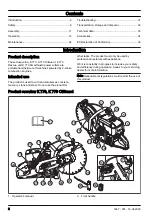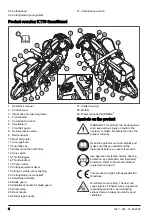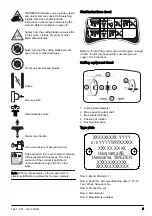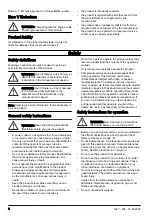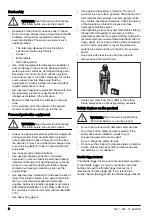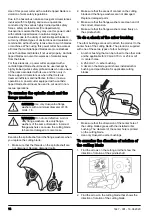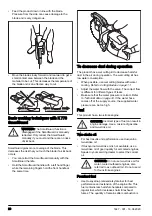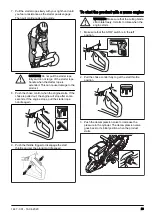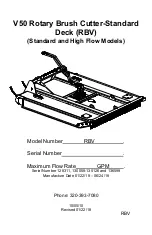
100 m/s
XXXX rpm
Note: Many cutting blades that can be attached to this
product are made for stationary saws. The rated speed
value of those cutting blades is too low for this product.
CAUTION: Do not use cutting blades with
thickness exceeding maximum
recommended thickness. Refer to
data on page 33
.
• Cutting blades applicable to this product are
available in two basic models; bonded abrasive
blades and diamond blades.
• Make sure that the cutting blade has the correct
center hole dimension for the installed arbor
bushing.
Cutting blade vibration
CAUTION: If you use the product with too
much force, the cutting blade can become
too hot, bend and cause vibrations. Use the
product with less force. If the vibrations
continue, replace the cutting blade.
Bonded abrasive cutting blades
WARNING: Do not use bonded abrasive
cutting blades together with water. Moisture
decreases the strength in the bonded
abrasive cutting blade and the cutting blade
can break and cause injury.
A bonded abrasive cutting blade is made of small
abrasive grains joined with an organic or vitrified bond,
molded with fabric reinforcements, which prevents the
cutting blade from breaking during high speed operation.
Bonded abrasive cutting blades for different
materials
Note: Make sure that you use the correct cutting blades
for rail cutting.
Blade type
Material
Concrete
blade
Concrete, asphalt, stone masonry,
cast iron, aluminum, copper, brass,
cables, rubber and plastic.
Metal blade
Steel, alloy steel and other hard met-
al.
Cutting blade
for rail cutting
Rail
To examine a bonded abrasive cutting blade
• Make sure that there are no cracks or damages on
the cutting blade.
• Hang the cutting blade on your finger and hit the
cutting blade lightly with a screwdriver. If you do not
hear a clear sound, the cutting blade is damaged.
xxxx
12
1447 - 001 - 16.04.2020


